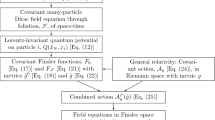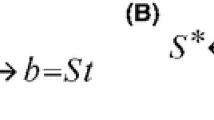Abstract
For about two centuries (1700 to 1900) physicists recognized only one dynamical theory1. Now three theories exist, of which the third may be subdivided:
-
(i)
Newtonian dynamics.
-
(ii)
Relativistic dynamics (with quantum theory excluded).
-
(iii)
(a) Newtonian quantum dynamics, based on the absolute space and time of Newton. (b) Relativistic quantum dynamics, based on the flat space-time of Minkowski or the curved space-time of Einstein.
Access this chapter
Tax calculation will be finalised at checkout
Purchases are for personal use only
Preview
Unable to display preview. Download preview PDF.
Similar content being viewed by others
General references
Ames, J. S., and F. D. Murnaghan: Theoretical Mechanics. Boston: Ginn 1929. — Vector analysis, including theory of screws. Kinematics. Dynamics of a particle and of a rigid body. Lagrangian and Hamiltonian equations. Variational principles. Hamilton-Jacobi equation. Poisson brackets. Relativity.
Appell, P.: Traité de Mécanique rationnelle. Paris: Gauthier-Villars, Tome I, 1941 (6th. Edn.); Tome II, 1953 (6th Edn.). — A classical treatise, presenting the subject in detail and with great clarity. Sparing use of vector notation. Tome I deals with kinematics, statics and the dynamics of a particle. Tome II deals with systems, holo-nomic and non-holonomic, Lagrangian and Hamiltonian equations with associated general theory, shocks and percussions. Three further volumes deal with continuous media, rotating fluid masses and tensor calculus.
Corben, H. C., and P. Stehle: Classical Mechanics. New York: Wiley, and London: Chapman & Hall 1950. — A modern textbook, with emphasis placed on those parts of the subject most pertinent to quantum mechanics. Vector and matrix notation used. Hamiltonian theory, Poisson brackets, and contact transformations. Introduction to special theory of relativity.
Finzi, B.: Meccanica Razionale. 2 volumes. Bologna: Zanichelli 1948. — A general textbook on mechanics, with some attention given to Lagrangian and Hamiltonian methods. Relativistic mechanics. Statistical mechanics.
Frank, Ph.: Analytische Mechanik. Die Differential- und Integralgleichungen der Mechanik und Physik, Teil 2, pp. 1–176. Braunschweig: F. Vieweg & Sohn 1927. — Lagrangian and Hamiltonian equations, transformation theory, Hamilton-Jacobi equation, action-angle variables, stability, rigid motions, perturbations.
Fues, E.: Störungsrechnung. Geiger-Scheel, Handbuch der Physik, Vol. V, pp. 131 to 177. Berlin: Springer 1927. — Multiply periodic motions, action-angle variables, degeneracy, adiabatic invariants, development in powers of parameter, secular disturbances, Delaunay’s method, time-dependent disturbances.
Goldstein, H.: Classical Mechanics. Cambridge, Mass.: Addison-Wesley 1950. — Emphasis on techniques required in quantum mechanics. Matrix and vector notations used. Special relativity. Hamiltonian equations, canonical transformations, small oscillations, introduction to Lagrangian and Hamiltonian formulations for continuous systems and fields.
Grammel, R.: Kinetik der Massenpunkte. Geiger-Scheel, Handbuch der Physik, Vol. V, pp. 305–372. Berlin: Springer 1927. — Dynamics of a particle, free or constrained. Motion relative to rotating earth. Two-body problem. Three-body problem. Stability.
Halpern, O.: Relativitätsmechanik. Geiger-Scheel, Handbuch der Physik, Vol. V, pp. 578–616. Berlin: Springer 1927. — Dynamics of a particle and of a continuum in special relativity. Light quantum. General relativity.
Hamel, G.: Die Axiome der Mechanik. Geiger-Scheel, Handbuch der Physik, Vol. V, pp. 1–42. Berlin: Springer 1927. — Newtonian laws. Construction of mechanics from continuity hypothesis, from rigid body, from particles. Construction from Lagrangian and energetic principles. Non-classical forms of dynamics. Absence of contradictions.
Hamel, G.: Theoretische Mechanik. Berlin: Springer 1949. — A comprehensive textbook, with detailed treatments of rigid body, n-body problem and non-holonomic systems; 263 pages devoted to problems and their solutions.
Jung, G.: Geometrie der Massen. Encyklopädie der mathematischen Wissenschaften, Vol. IV. 1, pp. 279–344. Leipzig: Teubner 1901–1908. — A specialized article on linear, quadratic and higher moments, with bibliography up to 1903.
Lamb, H.: Dynamics. Cambridge: University Press 1929 (2nd Edn.). — Elementary textbook, without vector notation, noteworthy for direct simple treatment of plane problems.
Lamb, H.: Higher Mechanics. Cambridge: University Press 1929 (2nd Edn.). — Sequel to [13], Geometry of finite rotations, screws and wrenches. Motion of rigid body in space. Lagrangian and Hamiltonian equations. Vibrations.
Lanczos, C.: The Variational Principles of Mechanics. Toronto: University of Toronto Press 1949. — D’Alembert’s principle. Lagrangian and Hamiltonian equations. Canonical transformations. Hamilton-Jacobi theory. Emphasis on the geometry of phase-space.
Levi-Civita, T., and U. Amaldi: Lezioni di Meccanica Razionale. Bologna: Zanichelli; Vol. I, 1923; Vol. II1, 1926; Vol. II2, 1927. — A comprehensive treatise, comparable to Appell [2]. Vol. I deals with kinematics, geometry of masses, and statics. Vol. II1, deals with dynamics of a particle, Lagrange’s equations, stability of vibrations. Vol. II2 deals with dynamics of a rigid body, Hamiltonian theory, variational principles, and impulsive motion.
Macmillan, W. D.: Theoretical Mechanics. New York and London: McGraw-Hill; Vol. I, 1927; Vol. II, 1936. — Comprehensive textbook with much detail. Vol. I deals with orbits, ballistic trajectories, Lagrangian and Hamiltonian equations and variational principles for a particle. Vol. II deals with a rigid body, with fixed point or rolling, impulsive forces, Lagrangian and Hamiltonian methods in general, method of periodic solutions.
Nordheim, L.: Die Prinzipe der Dynamik. Geiger-Scheel, Handbuch der Physik, Vol. V, pp. 43–90. Springer: Berlin 1927. — Differential and integral principles, virtual work, d’Alembert’s principle, principles of Gauss, Hertz, Hamilton, Jacobi.
Nordheim, L., and E. Fues: Die Hamilton-JACOBische Theorie der Dynamik. Geiger-Scheel, Handbuch der Physik, Vol. V, pp. 91–130. Berlin: Springer 1927. — Canonical transformations, Poisson and Lagrange brackets, Hamilton-J acobi equation, eikonal.
Peres, J.: Mécanique générale. Paris: Masson & Cie. 1953. — Compact textbook dealing with moments of inertia, non-holonomic constraints, virtual work, dynamics of a particle and of a rigid body, equations of Lagrange, Appell and Hamilton, Hamilton-Jacobi equation, stability about equilibrium or steady motion. Shocks and percussions.
Prange, G.: Die allgemeinen Integrationsmethoden der analytischen Mechanik. En-cyklopädie der mathematischen Wissenschaften, Vol. IV.2, pp. 505–804. Leipzig: Teubner 1904–1935. — Detailed treatment of d’Alembert’s principle, Lagrange’s equations, variational principles, variation of constants, Hamilton’s optics, characteristic function, Hamilton-Jacobi equation, separation of variables, integral invariants, systematic integration of canonical systems, canonical transformations, substitution or generating functions, equivalent systems.
Routh, E. J.: A Treatise on the Dynamics of a System of Rigid Bodies. London: Macmillan; Vol. I, 1897 (6th Edn.); Vol. II, 1905 (6th Edn.). German translation by A. Schepp, Leipzig 1898. Vol. II reprinted by Dover Publications, New York, 1955. — Although old-fashioned in notation, this book remains the most useful reference for miscellaneous special information on the dynamics of rigid bodies. Strings and membranes are also treated. The arrangement is unsystematic, but there is a good index.
Schaefer, Cl.: Einführung in die theoretische Physik, Bd. 1. Berlin: W. de Gruyter 1950 (5th Edn.). — The first 469 pp. of this book treat the dynamics of particles and rigid bodies in considerable detail, Lagrangian and Hamiltonian methods being included. The rest of the book (507 pp.) deals with the mechanics of continua.
Schoenflies, A., and M. Grübler: Kinematik. Encyklopädie der mathematischen Wissenschaften, Vol. IV. 1, pp. 190–278. Leipzig: Teubner 1901–1908. — Finite displacements, velocity, acceleration, linkages, mechanisms.
Stäckel, P.: Elementare Dynamik der Punktsysteme und starren Körper. Encyklopädie der mathematischen Wissenschaften, Vol. IV. 1, pp. 436–684. Leipzig: Teubner 1901–1908. — Direct treatment of the dynamics of particles and rigid bodies, with bibliography and detailed historical references. Gyroscopic motion handled rather fully, with diagrams.
Synge, J.L., and B.A. Griffith: Principles of Mechanics. New York-Toronto-London: McGraw-Hill 1959 (3rd Edn.). — Textbook of statics and dynamics up to gyroscopic theory. Motion of charged particles in axially symmetric electromagnetic field. Methods of Lagrange and Hamilton. Vibrations. Introduction to relativity.
Voss, A.: Die Prinzipien der rationellen Mechanik. Encyklopädie der mathematischen Wissenschaften, Vol. IV. 1, pp. 3–121. Leipzig: Teubner 1901–1908. — History and philosophy of mechanics, from Galileo and Newton. Elimination of force by Kelvin and Hertz. Principles of d’Alembert, Fourier, Gauss, Hamilton. Principle of energy.
Whittaker, E. T.: A Treatise on the Analytical Dynamics of Particles and Rigid Bodies. Cambridge: University Press 1937 (4th Edn.). Reprinted by Dover Publications, New York 1944. The 2nd Edition (1917) translated into German by F. and K. Mittelsten-Scheid (Berlin: Springer 1924). — Standard treatise, with systematic arrangement of material. More compact than Appell [2] or Levi-Civita and Amaldi [16], the usual problems of the dynamics of particles and rigid bodies being treated by Lagrangian methods, without vector notation or diagrams. The second half of the book deals with Hamiltonian systems, integral invariants, transformation theory, first integrals, three-body problem, theory of orbits.
Winkelmann, M., and R. Grammel: Kinetik der starren Körper. Geiger-Scheel, Handbuch der Physik, Vol. V, pp. 373–483. Berlin: Springer 1927. — The top, symmetric and unsymmetric, with many diagrams. Relative motion of a rigid body on the rotating earth. Systems of rigid bodies. Gyroscopic stability.
Wintner, A.: The Analytic Foundations of Celestial Mechanics. Princeton: University Press 1947. — The main theme is the n-body problem, but the book contains a compact critical treatment of Hamiltonian methods and canonical transformations, with interesting historical notes and references at the end.
Editor information
Rights and permissions
Copyright information
© 1960 Springer-Verlag Berlin Heidelberg
About this chapter
Cite this chapter
Synge, J.L. (1960). Classical Dynamics. In: Flügge, S. (eds) Principles of Classical Mechanics and Field Theory / Prinzipien der Klassischen Mechanik und Feldtheorie. Encyclopedia of Physics / Handbuch der Physik, vol 2 / 3 / 1. Springer, Berlin, Heidelberg. https://doi.org/10.1007/978-3-642-45943-6_1
Download citation
DOI: https://doi.org/10.1007/978-3-642-45943-6_1
Publisher Name: Springer, Berlin, Heidelberg
Print ISBN: 978-3-540-02547-4
Online ISBN: 978-3-642-45943-6
eBook Packages: Springer Book Archive




